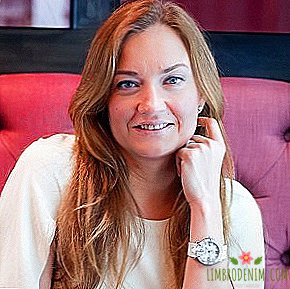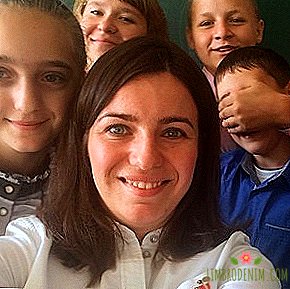How it works: photographer Solvé Sundsbo
During the year I worked as a personal assistant and junior producer of the photographer Solva Sundsbo. During this time, Solvé has shot dozens of stories for Vogue Italia, Vogue Nippon, Vogue Russia, Numero, Industrie, Love, Muse, Interview. Even more, he shot advertising campaigns for Chanel, Louis Vuitton, Dolce & Gabbana, Swarovski, Cartier, McQ. Each shooting is a separate story requiring a lot of preparation and production.
SOLVE SUNDSBOphotographer |
Solvay came to London from Norway when he was 20 years old. After graduating from London College of Printing, he became an assistant photographer Nick Knight in a few months. To be an assistant to a successful photographer is practically the only way to the profession. Most often, training takes about three years - this is a permanent employment, and daily acquaintance with something new, but also a daily routine.
Becoming an assistant to such a famous photographer as Nick Knight, Tim Walker or Solve Sundsbo is not easy: the competition is huge. The main qualities here are optimism, self-confidence, adequacy and maximum friendliness. They will come in handy when you have to not only do research, collect a mindboard for cool shooting, put on lights and chat with models, but also run for coffee, pick up tons of heavy magazines from editorial offices, try to find a spare generator in the middle of the desert and again run for coffee.
Usually assistants work with the photographer for about three years, after which they begin their own careers. From the outset, this is the minimum fees for tiny magazine shots, often - work in model agencies on the shooting of tests for new people. Acquired contacts and the person you worked for are very helpful: photographers are loyal to former assistants and are always ready to help them find orders.
Backstage shooting for Vogue Italia. Photos: Sasha Boyarskaya.
Solvay has its own small studio and office in East London, in Shoordic. Only four people work for him: his main producer is Paul, a personal assistant (he is a junior producer) and two permanent assistants. Paul, in fact, does all the affairs of Solvay, including financial ones, and keeps track of deadlines. I organized shooting and was engaged in the personal schedule of the photographer. Assistants set the light, deal with technical issues, monitor the studio. In addition, Solvay has his own agent in Art + Commerce - this is a huge company that represents photographers, stylists, designers, is engaged in the syndication of photos, the organization of filming. In addition to Solvay, Art + Commerce represents Tim Walker, Ellen von Unwerth, David Lashapelle, Stephen Meisel.
The most exciting in the work - shooting for magazines. There is a lot of freedom here and something interesting always happens. The idea of shooting sometimes belongs to the art director, after which he chooses a photographer or stylist, and they assemble a team at their discretion. Often the photographer himself comes with a story, then he personally selects the choice of stylist, model and details.
Working with magazines is something that a photographer spends a lot of time, fantasy, and often money, because it is seen more as a testing ground for his own creativity and portfolio creation, rather than a way to make money. Magazines pay a conditional fee, which often does not cover even a tenth of the production costs. For example, a three-week project with filming in New York, Los Angeles and London for i-D cost him about £ 25,000; at the same time, the fee for the cover and about 60 photos (Solvay shot the whole number) turned out to be less than £ 3,000. This is not the rule: i-D still occupies a special position, but it conveys the essence quite accurately.
You can earn money by shooting advertising campaigns of big brands like Dolce & Gabbana. In addition to the fee for the work and 10% of the budget, this includes the percentage for the organization. The payment also includes a usage fee, which allows you to earn in the photos in case of their prolonged use or a very successful (and therefore prolonged) advertising campaign.
After the magazine decided on the idea of shooting and the photographer, the work begins. Assistants conduct research on a given topic - these are hundreds of pictures, photos, images, video fragments and text related to the subject of shooting. The stylist usually introduces his ideas too. It is easier to tell about this process on the example of a specific survey. For example, take the beauty story from October Vogue Italia.
Stylist Katie Kasterin, working mainly for i-D and Vogue Italia, came to Solvay with the idea of removing several girls of new types in images typical of London in the 1950s and 1960s. The assistants searched for all the existing photos of Twiggy and Veruschka, watched movies and made mindboards. The shooting took place in the Solvay studio: it is sometimes easier to build scenery in the studio than to agree with the pub or the district administration that runs that street or courtyard where you want to photograph something. The "come and take off" option does not work here: we need light, two assistants, a digital operator with a powerful computer and a huge monitor, and more often two. A digital operator is a person who, in the process of shooting, looks at photographs on the screen, checks sharpness and checks colors. There were also a stylist and several assistants with three rails of clothes, a hair stylist (Samantha Hillerby worked on this shoot) with assistants and two suitcases of wigs, patch strands, hairbrushes and varnishes, and also a make-up artist, Lucia Pika with two suitcases and assistants, and manicurist - Sophie Robson and her hundreds of nail polishes. To assemble a team, you need to contact the agents of the participants. The main agencies involved in such filming in London are Streeters, CLM, D and V, Management Artists. Often the hair stylist chosen by the photographer is already booked for another shooting - you get the second option, which means that if something is canceled or transferred, then the stylist is at your disposal. On average, about 15 people are invited to each shooting, and it is important that they feel comfortable working with each other. The choice of models involved a photographer, stylist and art director. In the case of shooting for Vogue Italia, it was necessary to choose eight new faces with suitable types. We were looking for girls in not the biggest agencies - Tess Models and FM Models: it is more likely to find a fresh and interesting face. Relationship with model agencies is very important: if a girl who is perfect for a story in a magazine is in Los Angeles or New York, the agency, if it is interested in working with a photographer, will pay for her ticket and hotel accommodation. Every day, girls come to meet: for them it's casting, for us it's an opportunity to personally see new faces. |
On the day I look at about 4-5 model portfolios. The portfolio, by the way, is not only for models, but also for photographers, stylists, manicurists. These are huge books with magazine pages that are sent to advertising clients and agencies on request. All Solve's portfolio weighs more than 10 kilograms, they have hundreds of pages, and it was my responsibility to update them, change stories, pages and photos (depending on who you send the book to). I learned all the formats of magazine pages and now I can distinguish Pop from AnOther Magazine by the texture of the paper.
Two days before the shooting, you need to confirm all the stylists, cancel the spare options, paint the time for the models, order breakfast and lunch and make a call sheet - this is all the information about the shooting: names, agent phone numbers, studio address and phone number, arrival time, hotel addresses, phones and the time for which a taxi is ordered. Personal phones and emails are never indicated, especially for models.
Almost all shootings begin at 9:30 in the morning. The first frame takes the longest. The most time-consuming processes are hair styling and makeup. One girl can be dyed and combed for about 4 hours or longer. Most often, the first frame is ready by one o'clock, after which everyone goes to lunch. The work, as a rule, lasts until 7 pm, but in the case of magazine shots, of course, it can be delayed until midnight. This is all very trying to avoid.
After shooting, postproduction remains - color correction and retouching. Solve chooses the best photos - the art director will see them. The selection is very strict: most likely, there will not be even two variants of one frame. The retoucher makes a rough retouch and prints the first set of A3 photographs. Solvay writes his comments and sends the pictures back. Depending on the colors, setting the light, fashion or beauty photography - there can be from 2 to 10 sets of printed photos.
Work continues until Solvé is satisfied with the result. Sometimes the process takes about a month, and the cost of the work exceeds the cost of the shooting itself twice. Ready prints and a disk with photos are packed and sent to the editor with a courier. After two or three months, a journal comes out, and the photos are sent back: we send them to the archive. For a portfolio you need about 12 copies of each magazine, they come from the editors.
Shooting Solve Sundsbo for Vogue Italia
Sometimes shooting is much more insane. I remember well, for example, the search for an albino python for Naomi Campbell - now this photo adorns the cover of the October GQ in Russia. It was necessary to find the python in 24 hours, and the studio in which we shot Naomi demanded that two trainers come with a python and at least one doctor, just in case. Or another shooting for a new project - with a professional stuntman, dressed in the cloak of Gareth Pugh, the day before. The cloak lived a short life: the shooting was connected with fire, and we had one take and 15 seconds to take pictures, like a stuntman in a flaming cloak running through the field.
My favorite story was filmed for Vogue Nippon with model Alla Kostromicheva. For this shooting we built special transparent aquariums with heated water, we were looking for a model that swims well and can hold our breath, I wrote a million letters to the insurance company with assurances that everything would go smoothly. The main subject of the shooting - the underwater world - was ideal for the latest Alexander McQueen collection. And it so happened that the shooting came out immediately after his death.
In conclusion, it should be said that phenomenal diligence, responsibility and calmness, which I observe in Solvay, are incredibly important for a good photographer. This is something that novice photographers should learn: Shooting as a process must obey one person, and if he radiates self-confidence and friendliness, the atmosphere in the studio, even in a stressful situation, remains working.
And meticulousness is also important. It manifests itself in everything. Not to do something, not to think about some little things is simply impossible: responsibility is too great, so you begin to check all the details thirty times. In England there is a saying: "Better be safe than sorry" - and this is the rule by which it is much easier to work. There are almost no opportunities to be late for shooting: a taxi is ordered taking into account possible traffic and traffic jams; I check that the wake-up calls in the hotels are twenty minutes before the car arrives. There are always two cameras on the shoot - working and spare, in case something goes wrong. In the studio there is always a spare power source or generator, and so on.
Sometimes it seems that this is excessive, manic meticulousness - but even the fact that I remember minor things like the fact that Solvay drinks a double espresso with two sweetener pills helps the whole process not to stop. I never saw that Solvay raised his voice, or that the camera broke, or the electricity that had been turned off to disrupt the shooting, or that the stylist’s assistant forgot about some shoes, or that the manicurist did not have the right color of lacquer. Well, if this happens - no one will panic anyway: everyone calmly solves the problem, simply because they respect each other and their time.




